|
|
|
This image was created on 24 October 26 2018 on the bucket list Emperor Penguins of Snow Hill Island expedition via icebreaker. I used the no-longer available (except from BAA) Induro GIT 304L tripod/Mongoose-mounted Nikon AF-S NIKKOR 500mm f/5.6E PF ED VR lens with the Nikon AF-S Teleconverter TC-17E II (at 850mm!) and the Nikon D850. ISO 500. Matrix metering plus about 1 1/3 stops: 1/640 sec. at f/13 in Manual mode. AWB at 3:10:36pm on a cloudy, very-bright afternoon One AF point up and to the right of the center AF point/Single/Shutter-button AF as originally framed was active at the moment of exposure. The selected AF point was on the bird’s left eye (the one on our right). Focus peaking AF Fine-tune: +7. See the Nikon AF Fine-tune e-Guide here. Emperor Penguin chick tight head portrait |
Nikon AF-S NIKKOR 500mm f/5.6E PF ED VR Lens (with a nice extra)
David Hawkins is offering a Nikon AF-S NIKKOR 500mm f/5.6E PF ED VR lens in near-mint condition for a very low $2,596.94. The sale includes the front and rear caps, the lens strap, the soft case,a Wimberley P-20 lens plate (a $55.00 value), and insured ground shipping via major courier to lower-48 US addresses only. Your item will not ship until your check clears unless other arrangements are made.
Please contact David via e-mail or by phone at 1-727-215-7567 (Eastern time zone).
Yes, I loved this still hard-to-get lens a ton when I used Nikon gear. The Nikon PF series telephoto lenses are tremendously popular as they are relatively small and light and offer great reach. Both do well with the Nikon AF-S Teleconverter TC-14E III and with the Nikon AF-S Teleconverter TC-17E II.The latter gets you to 840mm with a full frame body. On my bucket-list-trip for the Emperor Penguins, I brought two D850 bodies, the 500 PF, and the Nikon 80-400 VR lenses! You can see more images from the Snow Hill Island trip in the Nikon 500 PF/D850 Does Emperor Penguins in Antarctica! blog post here. The 500 PF is still hard to come by and sells new for $$3,296.95. At $2596.95, David’s lens is a steal as you save an even $700.00. artie
What’s Up?
I did fairly well at sunrise, and then spent a fun hour at the Vulture Trees. On Thursday, after the endoscopy and the anesthesia, I had lots of energy. On Friday, I was beat. After my early morning photo session, I barely lifted a finger to do anything. I did sit on the couch and watch two great World Cup soccer games. Kudos to Croatia and Argentina for advancing to the quarterfinals. Both games were decided by penalty kicks. Condolences to Brazil, to the Dutch, and to Clemens Van der Werf, now living in the Netherlands.
Today is Saturday 10 December 2022. When I went into the kitchen early, there was a grasshopper on the kitchen floor. I left it. Though the morning forecast for ILE is calling for cloudy with a NW breeze, I will be heading down to the lake early, just in case there is a nice sunrise.
This blog post took about an hour to prepare and makes two hundred fifty-eight days in a row with a new, educational post just for you. Wherever you are and whatever you are doing, I hope that you too have a great day.
Please remember to use the B&H and Amazon links that are found on most blog pages and to use the BIRDSASART discount code at checkout when purchasing your new gear from Bedfords to get 3% back on your credit card and enjoy free second-day air FedEx. Please, also, consider joining a BAA IPT. You will be amazed at how much you will learn!
You can find some great photo accessories (and necessities, like surf booties!) on Amazon by clicking on the Stuff tab on the orange/yellow menu bar above. On a related note, it would be extremely helpful if blog-folks who, like me, spend too much money on Amazon, would get in the habit of clicking on the Amazon logo link on the right side of each blog post when they shop online. As you might expect, doing so will not cost you a single penny, but would be appreciated tremendously by yours truly. And doing so works seamlessly with your Amazon Prime account.
Please remember that if an item — a Delkin flash card, or a tripod head — for example, that is available from B&H and/or Bedfords, is also available in the BAA Online Store, it would be great, and greatly appreciated, if you would opt to purchase from us. We will match any price. Please remember also to use my B&H affiliate links or to earn 3% cash back at Bedfords by using the BIRDSASART discount code at checkout for your major gear purchases. Doing either often earns you free guides and/or discounts. And always earns my great appreciation.
|
|
|
This image was created on 9 December 2022 down by the lake near my home at ILE. Standing at full height, I used the no-longer available (except from BAA) Induro GIT 304L tripod/Levered-Clamp FlexShooter Pro-mounted Sony FE 400mm f/2.8 GM OSS lens and The One, the Sony Alpha 1 Mirrorless Digital Camera). The exposure was determined via Zebra technology with ISO on the Thumb Dial. ISO 320. 1/6400 sec. at f/3.2 (stopped down 1/3-stop) in Manual mode. When evaluated in RawDigger, the raw file brightness was determined to be just as I wanted it. AWB at 7:13:50am on just after sunrise on a clear morning. Tracking: Spot (S) AF-C with Bird Face/Eye detection worked just fine. Be sure to click on the image to enjoy a high-res version. The Vulture Trees backlit at sunrise |
It Was The Frog’s Fault!
(AKA, the dog ate my homework)
Today’s image is typical of the new concept I have been working on recently, shooting the Vulture Trees backlit from across the canal between the South Peninsula and the South Field. I’ve tried with focal lengths ranging from 400mm to 1200mm. Though I like this one a lot, I think that there is a chance to do even better. Keep reading and you can learn a few things.
The Sun Peeking into the Frame
Do you like that the sun is just peeking into the frame? Why or why not? As discussed here recently, with any part of an unmuted sun in the frame on a clear morning, the sun must be completely over-exposed. If you eliminate over-exposing it, the rest of the frame will necessarily be black. I tried for almost 30 minutes to mute the sun, but did not like any of the results. If you do not like the sun peeking into the frame, remember that it was the frog’s fault. Had I not spotted it on the kitchen floor that morning I would have gotten down to the lake a lot earlier, well before the sun came into view.
Why the Tripod?
Considering the following:
1- Being relatively short in length, and with all the weight toward the rear, The Sony 400mm f/2.8 lens is easy to hand hold.
2- I had a ton of shutter speed.
Why did I go to the trouble of setting up the tripod?
Bird-scapes
How does having a single, distinctive bird in the frame when creating bird-scapes help the image?
Is there a single, distinctive bird in the frame above? Which one?
Depth of Field Question
Why was there no need to stop down two or three stops to render the trees and birds sharp?
The Homer IPTs Late Registration Discounts
If you’ve been thinking of attending one of the great trips below, please contact me via e-mail to learn of the Late Registration Discounts; I will do my very best to make it happen.
|
|
All images from Homer or Kachemak Bay, AK |
2023 Homer/Kachemak Bay Bald Eagle IPTs
IPT #1: MON 20 FEB 2023 through the full day on FRI 24 FEB 2023. Five full days/20 hours on the boat: $5500.00. Limit 5 photographers/Openings: 2.
IPT #2: SAT 25 FEB 2023 through the full day on THURS 2 MAR 2023. Six full days/24 hours on the boat: $6600.00. Limit 5 photographers/Openings: 3.
IPT #3: FRI 3 MAR 2023 through the full day on TUES 7 MAR 2023. Five full days/20 hours on the boat: $5500.00. Limit 5 photographers. Openings: 2.
Save $1,500.00 by doing back-to-back trips. Save $2500 by doing all three trips.
These trips feature non-stop flight photography as well as many opportunities to create both environmental and point-blank portraits of one of North America’s most sought-after avian subjects: Bald Eagle (Haliaeetus leucocephalus). Other reliable subjects will include Sea Otter, Glaucous-winged and Short-billed (formerly Mew) Gulls.
In addition, we should see Common Murre, Black Guillemot, Pelagic Cormorant, two or three species of loons, and a smattering of ducks including two species of merganser, all three scoters, Common and Barrow’s Goldeneyes, Bufflehead, Harlequin, and Long-tailed Ducks. Close-range photographic chances for these species will require a ton of good luck. Some of these species, especially when in flocks, can, however, often be used effectively when creating bird-scapes.
If we need to be out early, we will be the first boat out. If conditions are great, we will stay out. And when there is a chance for sunset silhouettes, we will stay out and be in the right spot.
We will be traveling through gorgeous wilderness country; landscape and scenic opportunities abound.
Also featured is a professional leader, often referred to as the world’s most knowledgeable bird photography trip leader, who is conversant in Canon, Nikon, and Sony.
|
|
All images from Kachemak Bay in 2022! |
What You Will Learn
You will learn practical and creative solutions to everyday photographic problems. You will learn to see the shot, to create dynamic images by fine-tuning your compositions, to best utilize your camera’s AF system, and how to analyze the wind, the sky conditions, and the direction and quality of the light. This is one of the very few trips Homer trips available where you will not be simply put on the birds and told to have fun. You will learn to be a better photographer. But only if that is what you want.
You will learn to get the right exposure when it is sunny, when it cloudy-bright, when it is cloudy, when it is cloudy-dark, or when it is foggy. Not to mention getting the right exposure when creating silhouettes.
You will learn to make pleasing blurs working in manual mode and to create silhouettes working in Shutter Priority mode.
Most importantly you will learn to pick your best flight images from tens of thousands of images.
You will enjoy working with the two best and most creative boat captains on their sturdy, photography-spacious, seaworthy, open-deck crafts.
The second and third IPTs are the only Bald Eagle workshops that feature an incredibly helpful first mate.
Only five photographers (not the usual six), plus the leader.
Small group Photoshop, Image Review, and Image Critiquing sessions.
|
|
All images from Homer or Kachemak Bay, AK |
What’s Included
One four-hour or two two-hour(+/-) boat trips every day (weather permitting), all boat fees and boat-related expenses (excluding tips), ground transportation to and from the dock and back to the hotel each day, in-the-field instruction and guidance, pre-trip gear advice, small group post-processing and image review sessions, and a thank you dinner for all well-behaved participants. Airport pickup if possible)
What’s Not Included
Your airfare to and from Homer, AK (via Anchorage), the cost of your room at Land’s End Resort, all personal items, all meals and beverages, and tips for the boat captain and/or the first mate.
Please Note
On great days, the group may wish to photograph for more than four hours. If the total time on the boat exceeds 20 hours for the five-day trips, or 24 hours for the second trip, the group will share the additional expense at a rate of $225/hour.
Some folks may wish to rent their own vehicle to take advantage of local photographic opportunities around Homer.
Deposit Information
A $3000 non-refundable deposit/trip is required. You may pay your deposit with credit card or by personal check (made out to BIRDS AS ART) and sent via US mail only to Arthur Morris. PO Box 7245. Indian Lake Estates, FL 33855. Your balance, due 90 days before the date of departure, is payable only by check as above.
In Closing
I have been going to Homer off and on for close to two decades. Every trip has been nothing short of fantastic. Many folks go in mid-March. The earlier you go, the better the chances for snow. The only way to assure that you are on the best of the three trips is to sign up for all three. Can you keep up with me? If you have any questions, or are good to go for one, two, or all three trips, please let me know via e-mail or give me a call on my cell phone at 863-221-2372.
Typos
With all blog posts, feel free to e-mail or to leave a comment regarding any typos or errors.

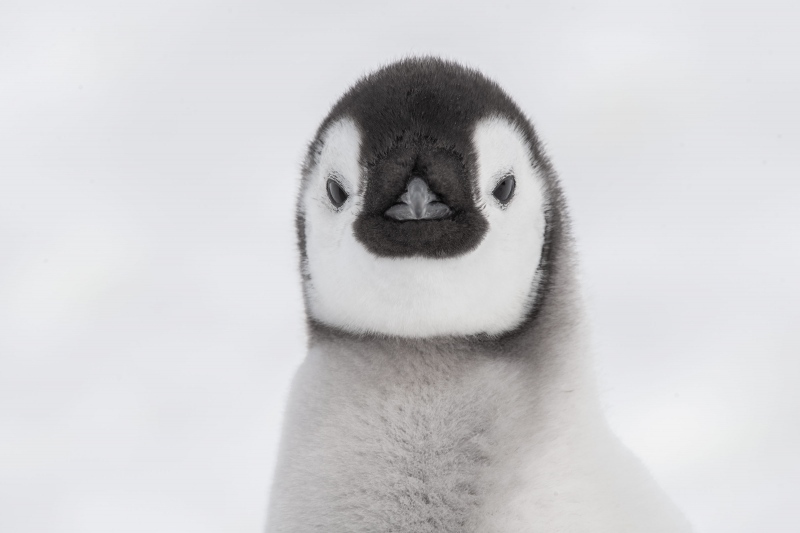
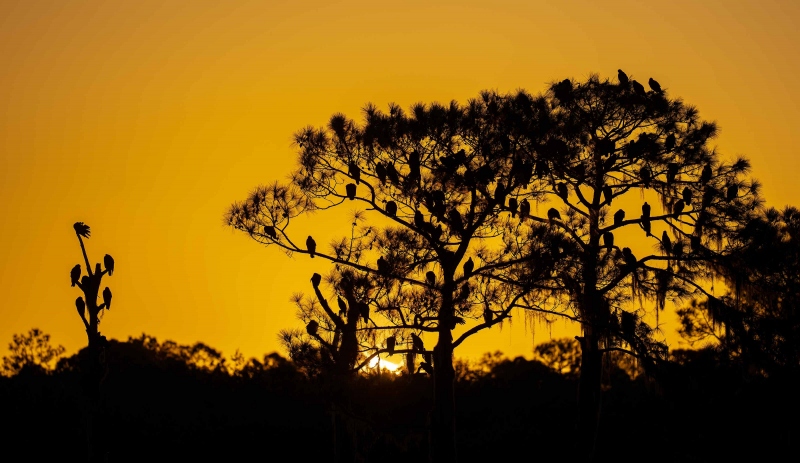
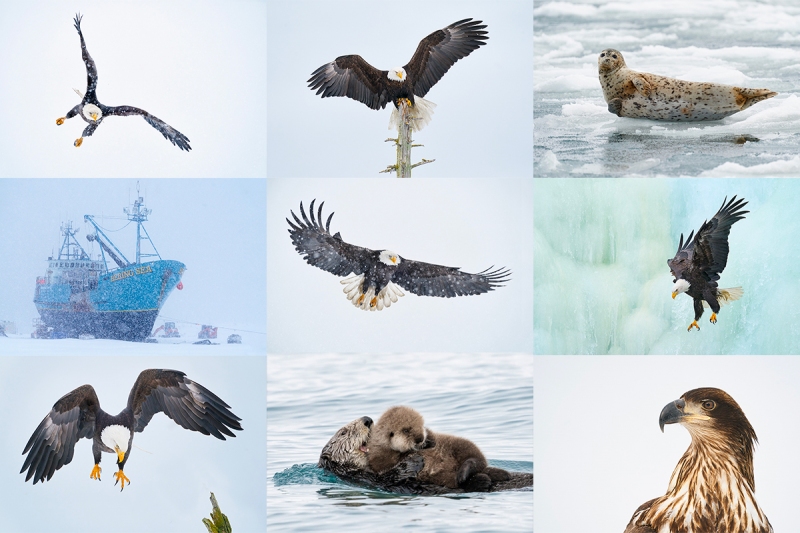
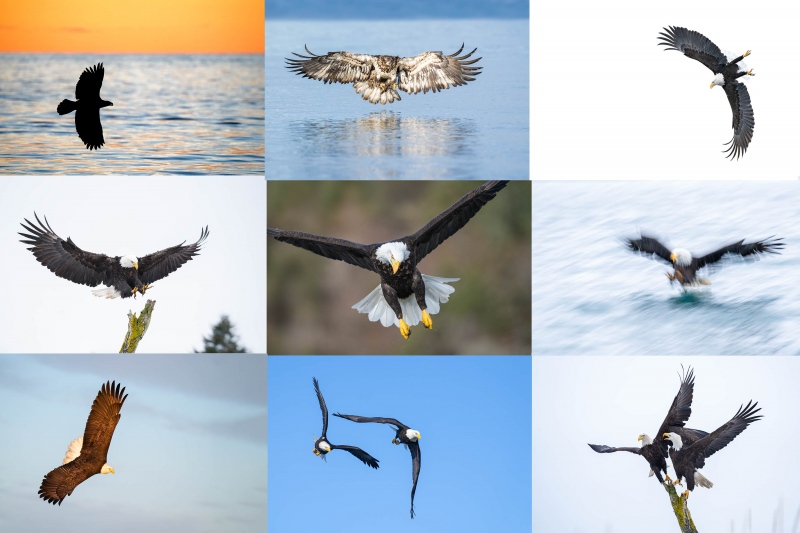
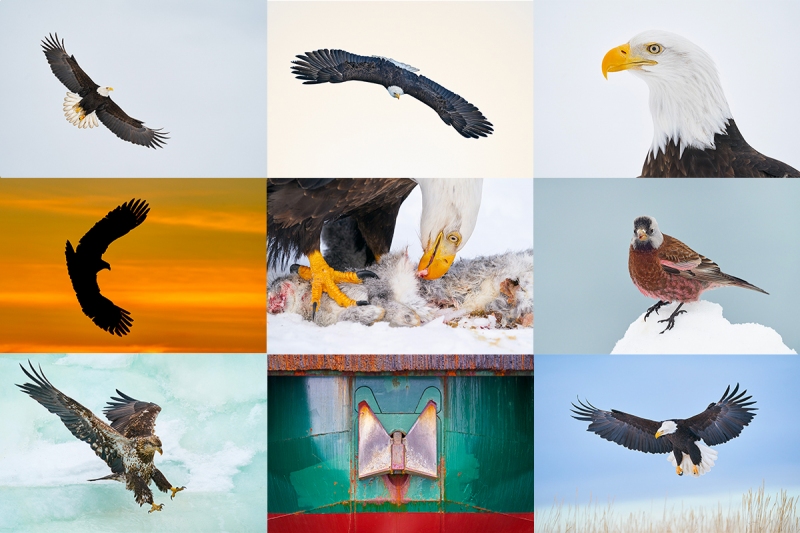













Depth of field. The answer is distance. The greater the distance between the sensor and the subject the greater the depth of field for any given focal length. The image subject is obviously some distance away and not fairly close.
That is correct, the distance to the subject is way more important than the wide aperture — f/2.8.
a
You used the tripod, so you would not have to look directly into the sun when taking the actual images (I assume you did take a series of images).
The leftmost vulture on the left lower branch of the big tree was the silhouette that I spotted first, since there was enough clear space around it.
The entire birdscape looks to be on the same focus plane, so there was no need to stop down.
Veit,
No to the first one. Yes to a series of images. Good work on noting the neatest bird on top of the tree. The tree branches were 30-50 feet so they were not all on the same plane.
a
Typo’s: How much is the Nikon 500 PF lens going for, $2496 or $2596?
Which was on the floor, grasshopper or frog?
Part of an un unmuted?
Thanks, Paul. There was a grasshopper on the floor but after what happened with the frog I was not taking any chances.
a
The little bit of the sun coming through the trees adds some depth to the image and helps with the story. I think the vultures on the trees in the left portion of the image are sharp and that is where my eye is drawn. You used a tripod so you would not have to continually hold the camera even though you had plenty of shutter speed. Your distance to the subjects is one of the reasons you did not need to stop down plus the compression of the long telephoto lens. FYI, for me, I would crop off about half of the black at the bottom horizontal of the frame.
Thanks, James, To my eye, the amount of black on the bottom is perfect. If I cropped some away, the image would seem top-heavy to me.
with love, artie
Love the sun just peeking up. It tells the story of when you were there. No need to stop down because all the trees were parallel to the back of the camera?
Thanks for the comment but the trees were 30-50 feet from front to back, yest all the branches are sharp.
a